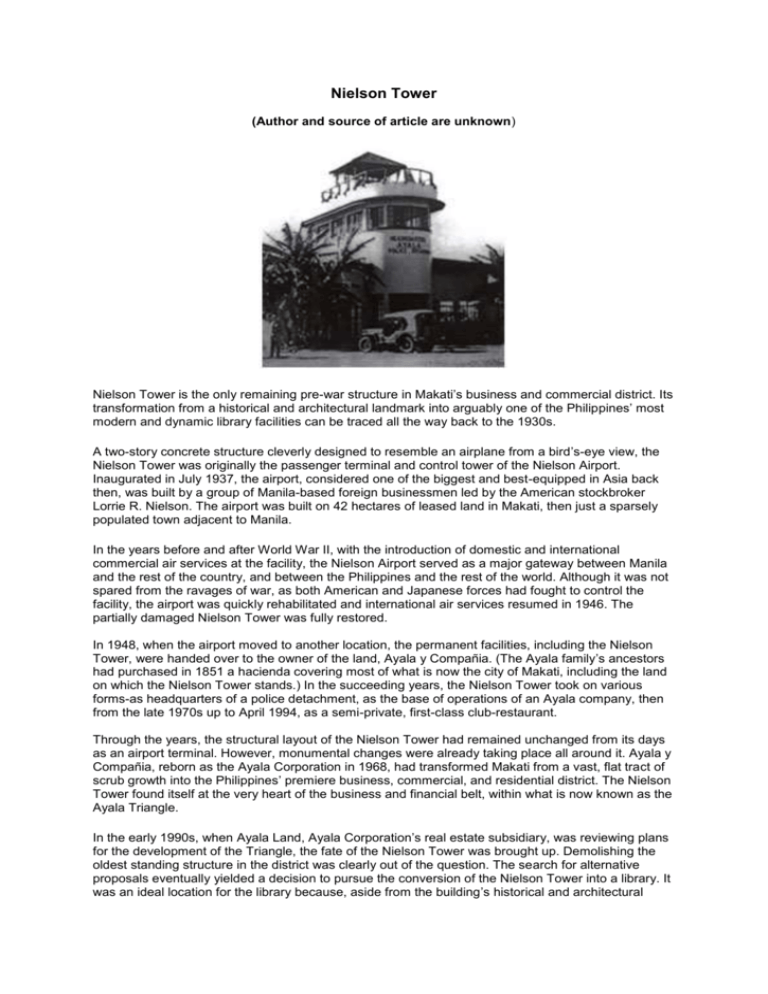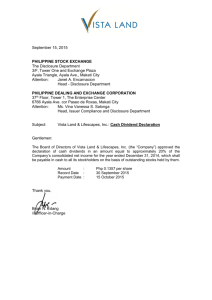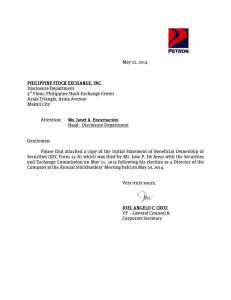Article on Nielson Tower - Museum Volunteers of the Philippines
advertisement

Nielson Tower (Author and source of article are unknown) Nielson Tower is the only remaining pre-war structure in Makati’s business and commercial district. Its transformation from a historical and architectural landmark into arguably one of the Philippines’ most modern and dynamic library facilities can be traced all the way back to the 1930s. A two-story concrete structure cleverly designed to resemble an airplane from a bird’s-eye view, the Nielson Tower was originally the passenger terminal and control tower of the Nielson Airport. Inaugurated in July 1937, the airport, considered one of the biggest and best-equipped in Asia back then, was built by a group of Manila-based foreign businessmen led by the American stockbroker Lorrie R. Nielson. The airport was built on 42 hectares of leased land in Makati, then just a sparsely populated town adjacent to Manila. In the years before and after World War II, with the introduction of domestic and international commercial air services at the facility, the Nielson Airport served as a major gateway between Manila and the rest of the country, and between the Philippines and the rest of the world. Although it was not spared from the ravages of war, as both American and Japanese forces had fought to control the facility, the airport was quickly rehabilitated and international air services resumed in 1946. The partially damaged Nielson Tower was fully restored. In 1948, when the airport moved to another location, the permanent facilities, including the Nielson Tower, were handed over to the owner of the land, Ayala y Compañia. (The Ayala family’s ancestors had purchased in 1851 a hacienda covering most of what is now the city of Makati, including the land on which the Nielson Tower stands.) In the succeeding years, the Nielson Tower took on various forms-as headquarters of a police detachment, as the base of operations of an Ayala company, then from the late 1970s up to April 1994, as a semi-private, first-class club-restaurant. Through the years, the structural layout of the Nielson Tower had remained unchanged from its days as an airport terminal. However, monumental changes were already taking place all around it. Ayala y Compañia, reborn as the Ayala Corporation in 1968, had transformed Makati from a vast, flat tract of scrub growth into the Philippines’ premiere business, commercial, and residential district. The Nielson Tower found itself at the very heart of the business and financial belt, within what is now known as the Ayala Triangle. In the early 1990s, when Ayala Land, Ayala Corporation’s real estate subsidiary, was reviewing plans for the development of the Triangle, the fate of the Nielson Tower was brought up. Demolishing the oldest standing structure in the district was clearly out of the question. The search for alternative proposals eventually yielded a decision to pursue the conversion of the Nielson Tower into a library. It was an ideal location for the library because, aside from the building’s historical and architectural value, the site was very accessible to the public and yet insulated from the noise and hustle and bustle of the surrounding area. The Ayala Foundation was also looking for a permanent home for its extensive collection of rare Filipiniana. In January 1994, Ayala Corporation chairman Jaime Zobel de Ayala gave the go-signal to Ayala Land and the Ayala Foundation to pursue the library project. Actual construction work began in May 1995. By January 1996, nine months later, the Nielson Tower was ready for occupancy by the Filipinas Heritage Library. The library was opened to the public on 23 April 1996, but the formal inauguration of the library was held on 23 August 1996, with President Fidel V. Ramos as the guest of honor. In the Philippines, historical and architectural landmarks have been sacrificed in the name of urban development and expansion. Some have been simply abandoned because there are just not enough resources to support conservation and restoration projects. The restored Nielson Tower has become a source of inspiration and national pride to those who have visited it and witnessed its transformation into the Filipinas Heritage Library.








